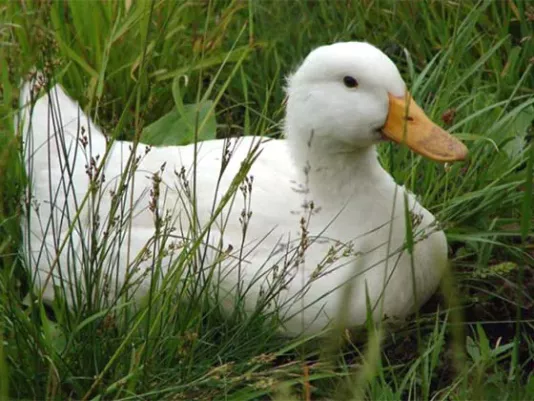Duck with Apples
Duck with apples – such a duck can be cooked for any occasion, its cooking does not require too much attention

Duck is a meat that requires understanding. Over the years in the kitchen, I’ve learned to appreciate it for its depth of flavor and its ability to absorb spices. It’s important not to confuse juiciness with fattiness: excess fat should be removed gradually, not along with the skin, to preserve texture. I always choose a medium-sized bird with clean legs and no odor – a sign of proper handling. Farm-raised ducks usually have more tender meat, while store-bought ones are more consistent in size. Before cooking, I leave it at room temperature for about half an hour so the fibers relax and don’t contract from the temperature contrast. If you give duck time, it will reward you with a clean, deep flavor that cannot be faked.
Over the years of cooking, I’ve realized that choosing the right duck determines not only the flavor but also the safety of the dish. It’s best to buy chilled rather than frozen – after thawing, the meat loses some moisture, becomes dense, and may cook unevenly. Fresh duck has firm, elastic, light-colored skin without spots or tears, and the fat underneath is pale yellow and even. If the skin feels sticky or overly glossy, it’s a sign of poor storage. I always press the breast with my finger: if the dent disappears quickly, the meat is fresh. Young ducks weigh up to two kilograms and have a more delicate texture, suitable for quick frying or roasting. Older ones hold their shape better during long stewing. When buying at a market, I’m not shy to ask the seller to show the belly – internal fat residue often reveals the bird’s age and quality. Always remember: the cleaner and more natural the duck looks, the more predictable the result will be on the plate.
Before starting heat treatment, I always do a thorough cleaning. First, I remove any remaining feathers – even one can ruin the impression of the finished dish. Then I carefully singe the duck to remove fine down, and pat it dry with paper towels. If the duck has excess fat inside the abdominal cavity, it should be gently trimmed – it’s great for frying potatoes or cabbage later. It’s important not to rush: I make cuts only where necessary for fat to render during frying. Before marinating, I chill the duck for at least an hour – this stabilizes the fibers and allows the marinade to penetrate evenly. In my practice, combinations of salt, sugar, garlic, and citrus notes work well – they enhance the natural taste of the meat. I never soak the whole bird in marinade – a thin coating is enough, with occasional turning. If you oversalt, the skin becomes tough, so moderation is key.
Temperature determines everything. Duck prefers moderate heat that allows the fat to render and form an even crust. I always start over medium heat, gradually lowering it as the skin turns golden. When roasting in the oven, I keep it at 200°C (392°F) for the first 20 minutes to start fat rendering, then reduce to 170°C (338°F) until done. This way the meat stays tender and the skin crispy. When pan-frying, it’s important not to move the duck too often – every unnecessary touch breaks the crust’s structure. During stewing, I add liquid gradually – too much makes the meat stringy. I avoid sudden temperature changes: putting cold duck directly into a hot oven causes the fibers to contract, making it tough. In my experience, the rule “heat enters slowly – flavor goes deep” always works.
Duck responds beautifully to both acidic and sweet notes. Over the years, I’ve tried it with apples, oranges, cherries, wine, honey, and even ginger – each adds a new dimension. For deeper flavor, I add dry red wine or balsamic vinegar to the sauce – the acidity balances the fat. For a lighter version, I use berries, especially cranberries or currants, which bring freshness. I always prepare the sauce separately, not in the same pan where I fry the duck, because the fat makes it heavy. To enrich the aroma, I add a bit of roasted garlic, bay leaf, and a few peppercorns. Duck pairs well with roasted vegetables, sauerkraut, or pearl barley – they absorb excess fat and enhance the flavor. For a festive option, I love finishing the dish with a thin glaze of orange syrup – it gives shine and fragrance.
The most common mistake is haste. Many try to shorten roasting time by raising the temperature, but that only dries the meat out. Duck requires patience: every stage – from drying to resting after the oven – affects texture. I always let it rest under foil for at least 10 minutes after cooking so the juices redistribute evenly. Another mistake is overusing spices: strong aromas drown out the natural flavor. Salt, pepper, and a light touch of acidity are enough. Never leave duck unattended while rendering fat – it can burn, giving the dish a bitter note. If I notice the skin browning too quickly, I cover it with foil, then remove it for final browning. I always judge not only by color but also by aroma: a properly cooked duck smells warm, nutty, and delicate, without sharp notes. That’s when I know – everything was done right.